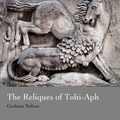The Reliques of Tolti-Aph — 31 of 57
Graham Nelson
Section E(b) - The Maze of Royal Beasts
[The Maze is a complex labyrinth which builds itself, randomly, as it is explored, and which is also randomly stocked with treasures, monsters, magical artefacts and hazards. Just as the whole of ROTA is loosely indebted to the late 1970s role-playing games, so the Maze is indebted to a contemporary board game - floor game, really - called "Sorcerer's Cave", a classic of this lost genre.
"Sorcerer's Cave" was published by Philmar, and then Gibson's: the best-known edition is from 1978, but all editions are long out of print. (As a sort of homage, I bought a copy up on Ebay after writing ROTA.) The "Cave" is an underworld labyrinth which extends itself across the floor. When a player wishes to move off one cave tile, he draws a new tile from the pack and lays it down in the appropriate space - face up if the connection works, that is, if the caves have connecting passageways which meet at the join; but face down if it doesn't work, because the exit from the existing cave doesn't match an entrance on the new one. Some caves are mere passageways or junctions, but others open out and are inhabited: the player draws from the "encounters pack" to see what can be found in such caves. Staircases down lead to deeper and rougher levels: whereas a first-level cavern involves drawing only a single encounter card, a third-level cavern involves drawing three, and if you have ever drawn the Sorcerer and two Spectres simultaneously then you will know the true meaning of unfairness.
All of this is clearly very difficult to implement in Inform, which is why it is included in ROTA, which is after all meant to be a worked example.
What makes the original "Sorcerer's Cave" work so well is that it is elegantly balanced, as a result of over two years of obsessive testing and modification by the designer, Terence Peter Donnelly. The encounter cards are beautifully judged to counterpoise each other, and recur in endless unexpected combinations. Donnelly tells the story nicely in his article for "Games and Puzzles" magazine (Autumn 1980), which can be found on the web. I haven't stuck exactly to the original, or even nearly so, but the basic ingredients are mostly the same. I had a minor pang of conscience about this, but Donnelly himself says that he finally ended up dropping ideas from D&D into the "Cave" design, despite having started out "misguidedly" trying to avoid this. So I feel I am in good company.
On with the show, but let me encourage curious readers to seek out the original game, or indeed Donnelly's equally recommendable table-top sequel "Mystic Wood". (The fact that level 1 of our Maze is above ground and wooded is a nod to this sequel, as is the range of quests.)]
